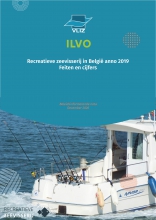
The new results of the national monitoring programme for Belgian marine recreational fisheries, with the focus year 2019, reveal higher catches of sea bass compared to 2018, but also indicate a worrying decline in cod catches in the southern North Sea.
Today, the second monitoring report on marine recreational fisheries in Belgium was published, with the focus year 2019. This publication focuses exclusively on recreational catches in the Belgian part of the North Sea. Flanders Marine Institute (VLIZ) and the Institute for Agricultural, Fisheries and Food Research (ILVO) have developed a tailor-made methodology for this purpose, which largely builds on the voluntary catch reporting by marine recreational fishermen. More than just contributing to this data collection programme, this unique collaboration with recreational fishermen results in additional insights on the evolution of the local marine ecosystem as well as on the effectiveness of fisheries management measures (e.g. cod management plan, European sea bass measures).
In 2019, Belgian marine recreational fishermen caught 890,000 fish. 38% were found to be undersized and discarded, while oversized discards amounted 7%. The limited discarding of oversized fish indicates a recreational sea fishing practice for personal consumption and less from a catch-and-release perspective. 55% of the catch was retained, accounting for 150.2 tonnes, i.e. a 39% decrease compared to 2018 (246.6 tonnes). In terms of landing volume, the main species are brown shrimp (24%), whiting (20%), mackerel (19%), dab (14%), sole (9%) and sea bass (8%). With landings of 90.8 tonnes, boat anglers account for 60% of the total volume of fishery products landed, followed by boat trawlers (30.5 tonnes), anglers from a dam/jetty (12.3 tonnes), beach anglers (8.0 tonnes), waders (5.7 tonnes) and passive beach fisheries (2.8 tonnes).
Sea bass and mackerel are the only species with a higher total catch (retained + discards) and higher landings compared to 2018. The increase in landings of sea bass (+1,200%) is largely due to the gradual relaxation of strict European measures to protect the sea bass stock. On the other hand, the increase in the total catch (+74%) is a first positive signal concerning the evolution of the seabass stock off the Belgian coast, although it is too early today to make any firm pronouncements in this respect. A further monitoring of the multi-annual evolution is therefore recommended.
The largest decreases in landings compared to 2018 are for cod (-90%) and grey shrimp (-61%). The reduction in recreational landings of shrimp follows the reduction in commercial landings by Belgian fishing vessels (also -50% compared to 2018). Due to the high annual variability, this is probably more of a temporary phenomenon. On the other hand, the population of cod in the southern North Sea has been in continuous decline for ten years. This accelerated and extremely sharp decline over the past year is therefore worrying and confirms the earlier reports of stock decline received by recreational fishermen. This trend therefore raises questions about the effectiveness of the current recovery measures for cod stocks in the southern North Sea.
The full report can be downloaded here (in Dutch - English summary available).